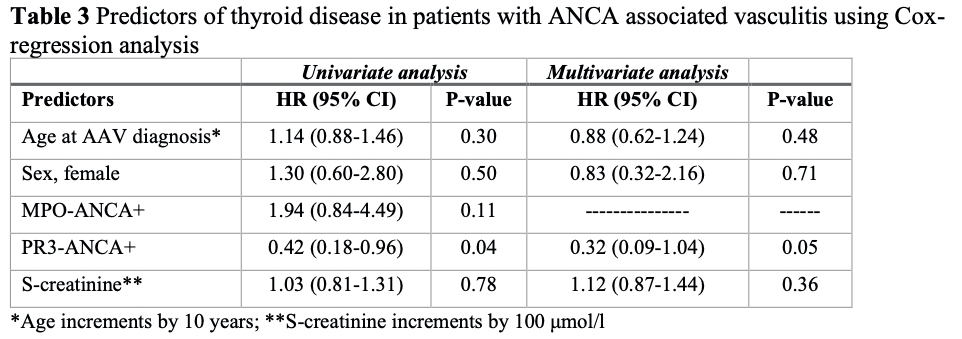Session Information
Session Type: Poster Session C
Session Time: 9:00AM-11:00AM
Background/Purpose: A higher incidence of thyroid disease has been seen in patients with anti-neutrophil cytoplasmic antibody (ANCA)-associated vasculitis (AAV). We aim to assess the incidence rate, patients’ characteristics and predictors of thyroid disease in patients with AAV.
Methods: Patients were included from two well characterized cohorts of AAV: (i) a population-based cohort from Southern Sweden and (ii) a cohort from a specialized centre; the Vasculitis and Lupus clinic, Addenbrookes Hospital, Cambridge, UK. Diagnosis of AAV was confirmed by review of medical records and patients were classified into AAV disease phenotypes according to the European Medicines Agency Algorithm 2007. The medical records were reviewed to identify patients with thyroid disease. The diagnosis of thyroid disease was supported by clinical characteristics, laboratory data and medication history and in some cases histopathology and radiological findings when available. Demographics, laboratory and clinical data from the date of AAV diagnosis were collected. Cases of thyroid diagnosis after AAV onset were included in incidence and predictor analyses. Patient-years of follow up were calculated from AAV diagnosis to the earliest of thyroid diagnosis, death or end of study (Southern Sweden 01/Jan/2019, Cambridge 01/Oct/2019. Vasculitis disease activity was assessed by the Birmingham Vasculitis Activity score. Irreversible organ damage was evaluated according to the Vasculitis Damage Index. Cox regression analysis was employed to study predictors of thyroid disease. The following variables from the time of AAV diagnosis were studied: Age, sex, ANCA specificity (proteinase-3 and myeloperoxidase) and serum creatinine.
Results: A total of 649 patients were included in this study (Lund = 325, Cambridge. = 324). 134 (21%) patients were diagnosed with thyroid disease, 29 (4.5%) were diagnosed after the onset of AAV. Table 1 summarizes clinical and outcome characteristics of all patients. Thyroid disease was more common in females and patients positive for MPO-ANCA. The incidence of all thyroid disease rate per 100 000 person-years of follow-up after AAV diagnosis was 608 for the whole study population, 781 in Lund-Sweden and 478 in Cambridge, UK, Table 2. The incidence rate for hypothyroidism was 344 /100 000 person-years and for hyperthyroidism 144/100 000 person-years. In Cox regression analysis a positive PR3-ANCA was associated with a lower risk of being diagnosed with thyroid disease even after adjustment for age and sex, Table 3.
Conclusion: After an AAV diagnosis the incidence of thyroid disease is higher than in the general population (incidence of hyperthyroidism in Sweden 25.8-43/100 000 person-years and incidence of hypothyroidism in UK, up to 297/100 000 person-years(1)). PR3-ANCA positivity is associated with less risk for thyroid disease after an AAV diagnosis, this is also true after adjustment for age and sex.
- Taylor PN, Albrecht D, Scholz A, Gutierrez-Buey G, Lazarus JH, Dayan CM, et al. Global epidemiology of hyperthyroidism and hypothyroidism. Nature Reviews Endocrinology. 2018;14(5):301-16.
To cite this abstract in AMA style:
Wilding A, Smith R, Jayne D, Segelmark M, Mohammad A. Thyroid Disease in ANCA-associated Vasculitis. a Population-based Study [abstract]. Arthritis Rheumatol. 2020; 72 (suppl 10). https://acrabstracts.org/abstract/thyroid-disease-in-anca-associated-vasculitis-a-population-based-study/. Accessed .« Back to ACR Convergence 2020
ACR Meeting Abstracts - https://acrabstracts.org/abstract/thyroid-disease-in-anca-associated-vasculitis-a-population-based-study/



